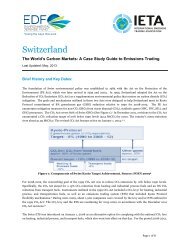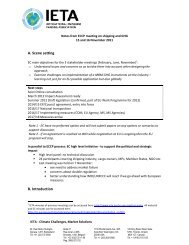Japan / The World's Carbon Markets - IETA
Japan / The World's Carbon Markets - IETA
Japan / The World's Carbon Markets - IETA
You also want an ePaper? Increase the reach of your titles
YUMPU automatically turns print PDFs into web optimized ePapers that Google loves.
Domestic <strong>Markets</strong>:<br />
According to <strong>Japan</strong>’s former National Strategy Minister, Koichiro Gemba, the primary reason that the <strong>Japan</strong>ese ETS<br />
was deferred was because fellow nations (particularly the United States and Australia) struggled to develop their own<br />
robust climate policies. 21 <strong>The</strong> lack of international action presumably made it more difficult to overcome industry<br />
concerns over the economic consequences of the program. A September 2010 Nippon Keidanren-led survey<br />
questioned <strong>Japan</strong>’s most influential businesses and found that 61 out of 64 companies opposed the ETS. 22 In<br />
November 2012, <strong>Japan</strong>ese ETS as proposed in the Basic Act was formally abandoned when Prime Minister Noda<br />
dissolved the Lower House. 23<br />
DETAILS OF THE EMISSIONS TRADING PROGRAM PROPOSED BY THE JAPANESE MINISTRY OF<br />
ENVIRONMENT IN 2010: 24<br />
• Two phases: Phase I (2013-2015) and Phase II (2016-2020).<br />
• Covered gases: Initially only CO2, but there were considerations for including other gases. CO2 is responsible for<br />
95% of <strong>Japan</strong>ese GHG emissions.<br />
• Covered sectors: Primarily industry, business, and energy conversion.<br />
• Allowance Distribution: Each sector would have received an absolute emissions cap based on sector-specific<br />
emissions reduction potential.<br />
• Point of obligation: Downstream, firm-level.<br />
• Inclusion: Covered entities must hold an allowance for every unit of CO2 generated that exceeded emissions<br />
thresholds.<br />
• Banking: Allowed, but few details were determined.<br />
• Borrowing: To be determined.<br />
• Offsets: Emissions reductions and carbon sinks from domestic entities not covered by the program as well as<br />
valid international offsets offered via the Kyoto mechanism would have been included.<br />
• International linkage intentions: To be determined.<br />
• Price Volatility Measures: Cost-containment reserve.<br />
• Compliance: One-year commitment periods and penalties for non-compliance.<br />
• Monitoring, Reporting and Verification (MRV): Uniform emissions rules for reporting with third-party<br />
verification based on international standards.<br />
While this proposed nation-wide ETS was characterized by opponents as an ‘economic burden,’ an expert panel from<br />
the Environmental Ministry projects that such a program, which could have cut GHGs by up to 18% relative to<br />
BAU by 2020, would have had little adverse effect on <strong>Japan</strong>ese GDP or job growth. If <strong>Japan</strong>ese firms were to cut<br />
emissions 10% below 2006-2008 averages, the nation’s GHGs would be reduced by 84 MtCO2, an 18% reduction<br />
relative to the scenario that does not include the program, and the natural fall in employment of the productive<br />
population through 2020 would be less than 0.3%. 25<br />
JAPANESE VOLUNTARY EMISSIONS TRADING SYSTEM (JVETS): In September 2005, the Ministry of<br />
Environment <strong>Japan</strong> (MOEJ) constructed the <strong>Japan</strong>ese Voluntary Emissions Trading System (JVETS) to<br />
provide government support for <strong>Japan</strong>ese companies to reduce emissions through activities not supported by the<br />
Voluntary Action Plan (VAP). 26 <strong>The</strong> Competent Authority Committee (CAC), under MOEJ, managed JVETS; CAC<br />
drafted guidelines, approved monitoring plans and verification reports, and evaluated verifiers’ achievements. 27<br />
JVETS participants became part of the Experimental Integrated ETS in 2008. 28<br />
Page 3 of 9










![South Korea [PDF] - International Emissions Trading Association](https://img.yumpu.com/38055599/1/190x245/south-korea-pdf-international-emissions-trading-association.jpg?quality=85)
